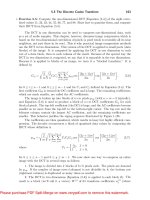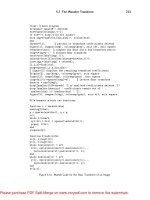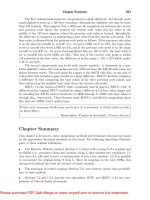a concise introduction to additives for thermoplastic polymers
Bạn đang xem bản rút gọn của tài liệu. Xem và tải ngay bản đầy đủ của tài liệu tại đây (2.49 MB, 284 trang )
A
Concise Introduction
to Additives
for
The
r
m
o
p
I
as
t
i
c
Po
I
y m
e
rs
Johannes Karl Fink
Montanuniversitat Leoben, Austria
S/c
r
ive
n
er
@WILEY
This Page Intentionally Left Blank
A
Concise Introduction
to Additives for
Thermoplastic Polymers
Scrivener Publishing
3
Winter Street, Suite
3
Salem, MA
01970
Scrivener Publishing Collections Editors
James
E.
R.
Couper
Rafiq Islam Pradip Khaladkar
Norman Lieberman Peter Martin
W.
Kent Muhlbauer Andrew
Y.
C. Nee
S. A. Sherif James
G.
Speight
Richard Erdlac
Publishers
at
Scrivener
Martin Scrivener
()
Phillip Carmical
()
A
Concise Introduction
to Additives
for
The
r
m
o
p
I
as
t
i
c
Po
I
y m
e
rs
Johannes Karl Fink
Montanuniversitat Leoben, Austria
S/c
r
ive
n
er
@WILEY
Copyright
Q
2010 by Scrivener Publishing, LLC. All rights reserved.
Co-published by John Wiley
&
Sons, Inc., Hoboken, New Jersey and Scrivener Publishing, LLC, Salem,
Massachusetts.
Published simultaneously in Canada.
No
part of this publication may be reproduced, stored in a retrieval system,
or
transmitted in any form
or by any means, electronic, mechanical, photocopying, recording, scanning, or otherwise, except as
permitted under Section 107 or 108 of the 1976 United States Copyright Act, without either the prior
written permission of the Publisher, or authorization through payment of the appropriate per-copy fee to
the Copyright Clearance Center, Inc., 222 Rosewood Drive, Danvers, MA 01923, (978) 750-8400, fax
(978) 750-4470, or
on
the web at www.copyright.com. Requests to the Publisher for permission should
be addressed to the Permissions Department,
John
Wiley
&
Sons, Inc., 11
1
River Street, Hoboken, NJ
07030, (201) 748-601
1,
fax (201) 748-6008,
or
online at
lgo/permission.
Limit of Liability/Disclaimer of Warranty: While the publisher and author have used their best efforts in
preparing this book, they make no representations or warranties with respect to the accuracy or
completeness of the contents of this book and specifically disclaim any implied warranties of
merchantability or fitness for a particular purpose. No warranty may be created or extended by sales
representatives
or
written sales materials. The advice and strategies contained herein may not be
suitable for your situation.
You
should consult with a professional where appropriate. Neither the
publisher nor author shall be liable for any loss of profit
or
any other commercial damages, including
but not limited to special, incidental, consequential, or other damages.
For
general information on our other products and services or for technical support, please contact
our
Customer Care Department within the United States at (800) 762-2974, outside the United States at
(317) 572-3993 or fax (317) 572-4002.
Wiley also publishes its books in a variety of electronic formats. Some content that appears in print may
not be available in electronic format. For information about Wiley products, visit
our
web site at
www.wiley.com.
For more information about Scrivener products please visit
www,scrivenerpublishing.com.
Cover designed by Russell Richardson.
Library
of
Congress Cataloging-in-Publication Data is available.
ISBN 978-0-470-60955-2
Printed in the United States of America.
10987654321
Contents
Preface
xiii
1
Introduction
1.1
Classification
References
2
Plasticizers
2.1 Principle of Action
2.2 Principle of Selection
2.3 Characterization
2.4 Risks and Drawbacks
2.4.1 Leaching
2.4.2 Inherent Toxicity
2.5 Classes of Plasticizers
2.5.1 Phthalate Plasticizers
2.5.2 Cyclohexanoic Diesters
2.5.3 Phophate Plasticizers
2.5.4 Aliphatic Esters
2.5.5 Polymeric Plasticizers
2.5.6 Ionic Liquids
2.6 Specific Examples of Application
2.6.1 Heat Shrinkable Films
2.6.2 Adhesive Compositions
2.6.3 Interlayer Films for Safety Glasses
2.6.4 Electrolyte Membranes
2.6.5 Porous Electrodes
2.6.6 Biodegradable Polymers
2.6.7 Plasticizers for Energetic Polymers
References
1
1
3
5
6
6
7
8
8
9
9
9
12
13
13
14
15
16
16
17
17
18
18
19
20
21
V
vi
Contents
3
Fillers
3.1
Surface Modification
3.1.1
Siloxanes
3.1.2
Dispersion and Coupling Additives
3.2
Special Applications
3.2.1
Flame Retardant Fillers
3.2.2
Conductive Fillers
3.2.3
Solder Precoated Fillers
3.2.4
Nan0 Clays
3.2.5
Mixed Matrix Membranes
References
4
Colorants
4.1
Physics Behind a Color
4.1.1
Human Eye
4.1.2
Tristimulus Values
4.1.3
Color Spaces
4.2
Color Index
4.3
Test Standards
4.4
Pigments
4.5
Organic Colorants
References
5
Optical Brighterners
5.1
Basic Principles
5.2
Measurement
5.3
Inorganic Brighteners
5.4
Organic Optical Brighteners
5.4.1
Reactive Optical Brighteners
5.4.2
Melt Extrusion
5.4.3
Photographic Supports
References
6
Antimicrobial Additives
6.1
Modes of Action
6.2
Plasticizers
6.1.1
Types of Irritations
25
25
25
25
29
29
30
32
33
34
34
37
37
37
37
39
40
41
43
43
47
49
50
51
52
52
52
54
55
56
59
59
60
60
Contents
vii
6.3 Special Formulations
6.3.1 Contact Lenses
6.3.2 Food Packaging
6.3.3 Polymers with Inherent
Antimicrobial Properties
References
7
Flame Retardants
7.1 Mechanisms of Flame Retardants
7.2 Smoke Suppressants
7.3 Admixed Additives
7.4 Bonded Additives
References
7.1.1 Flame Cooling of Halogens
7.4.1 Examples of Polymers
8 Lubricants
8.1
Principle of Action
8.2 Methods of Incorporation
8.2.1 Conventional Method
8.2.2 Separate Delivery of the Lubricant
8.3 Types of Lubricants
8.3.1 Alcohols
8.3.2 Fatty Acids, Esters and Amides
8.3.3 Waxes
8.3.4 Polymeric Lubricants
8.4.1 PVC
8.4.2 Chlorinated PVC
8.4.3 Electically Conductive Polymers
8.4 Special Applications
References
9
Antistatic Additives
9.1 Types of Additives
9.2 Areas of Application
9.3 Additives in Detail
9.3.1 Conventional Additives
9.3.2 Polymeric Additives
65
65
66
67
68
71
71
71
73
74
77
77
83
87
87
88
88
88
89
89
90
90
91
91
91
91
92
92
95
95
96
98
98
100
viii
Contents
9.3.3 External Antistatic Additives
9.3.4 Intrinsically Antistatic Compositions
9.3.5 Conductive Fillers
References
10 Slip Agents
10.1
Basic Principles
of
Action
10.2 Compounds
10.3 Special Formulations
10.3.1 Poly(ethy1ene terephthalate)
10.3.2 Formulations for Poly(ethy1ene)
References
11
Surface Improvers
11.1
Additives
11.1.1
Fluorocarbon Compounds
11.1.2 Acrylics
11.1.3
Modified Pigments
11.1.4 Organic Salts
References
12 Nucleating Agents
12.1 Crystalline Polymers
12.1.1 Crystal Structures
12.1.2 Modification
of
Properties by
Crystallinity
12.2 Experimental Methods
12.2.1 Nucleation Technologies
12.2.2 Characterization
of
Polymer
Crystallization
12.3 Classes
of
Nucleating Agents
12.3.1 Inorganic Nucleating Agents
12.3.2 Sorbitol Compounds
12.3.3 Phosphates
12.3.4 Carbon Nanotubes
12.3.5 Coupled Nucleating Agents
101
101
101
104
107
107
109
110
110
111
111
113
114
114
114
115
116
116
119
120
120
120
121
121
121
122
122
123
124
124
124
Con
tents
ix
12.4
Crystallization Accelerators
12.5
Clarifying Agents
References
13
Antifogging Additives
13.1
Field of Use
13.2
Principles of Action
13.3
Conventional Compounds
13.4
Compounds for Grafting
References
13.2.1
Thermodynamics of Surfaces
14
Antiblocking Additives
14.1
Examples of Uses
14.1.1
Film Resins
14.1.2
Sealable Coatings
14.1.3
Membranes
14.1.4
Poly(viny1 butyral)
References
15
Hydrolysis
15.1
Hydrolytic Degradation
15.1.1
Ordinary Hydrolysis
15.1.2
Enzymatic Hydrolysis
15.1.3
Stabilization
15.2.1
Poly(ester)s
15.2.2
Poly(ester urethane)s
15.2.3
Poly(1actide)s
15.2
Polymers
References
16
Dehydrochlorination Stabilizers
16.1
Dehydrochlorination of PVC
16.2
Stabilizers
16.2.1
Alkyl Tin Compounds
16.2.2
Mixed Metal Compounds
16.2.3
/3-Diketones
124
125
125
127
127
128
128
130
133
135
137
138
138
140
141
142
144
145
145
145
146
146
146
147
147
148
149
151
151
152
154
155
155
X
Contents
16.2.4
Epoxidized fatty acids
16.2.5
Hydrotalcite Clays
16.2.6
Zeolites
16.2.7
Costabilizers
References
17
Acid Scavengers
17.1
Acid Scavenging
17.2
Examples of Formulation
17.2.1
Poly(o1efin)s
17.2.2
Poly(ethy1ene terephthalate)
17.2.3
Poly(urethane)s
References
18
Metal Deactivators
18.1
Action of Metals in Polymers
18.2
Usage
18.2.1
Residues of Catalysts
18.2.2
Metallic Reinforcing Parts
18.3
Examples of Metal Deactivators
18.3.1
Side Effects
References
19
Oxidative Degradation
19.1
Autoxidation
19.2
Inhibition of Autoxidation
References
20
Degradation
by
Light
20.1
Photolysis
20.1.1
Redox Catalysis
20.1.2
Scavenging
20.2
Photooxdation
20.3
UV Stabilizers
References
21
Blowing Agents
21.1
Blowing Agents
21.1.1
Physical Blowing Agents
155
156
157
158
158
161
161
162
162
163
163
163
165
165
166
166
166
167
169
170
173
173
174
183
185
189
190
190
191
193
195
197
197
198
Contents
xi
21.1.2
Chemical Blowing Agents
21.2
Ozone Depletion Potential
21.3
Test Methods
21.4
Special Applications
21.4.1
Poly(urethane) Foams
21.4.2
Poly(imide) Foams
21.4.3
Poly(ethy1ene) Foams
References
22
Compatibilizers
22.1
Estimation of Compatibility
22.1.1
Glass Transition Temperature
22.1.2
Hildebrand Solubility Parameters
22.2.1
Classification
22.2.2
Reactive Processing
22.3.1
Block Copolymers as Compatibilizers
22.3.2
Poly(o1efin) Blends
22.3.3
Poly(amide) Blends
22.3.4
Poly(carbonate) Blends
22.3.5
Composites of PVC and Cellulosic
22.3.6
Packaging Applications
22.2.
Compatibilizers
22.3
Special Examples
Materials
References
23
Prediction of Service Time
23.1
Accelerated Aging
23.1.1
Cumulative Material Damage
23.1.2
Arrhenius Extrapolation
23.1.3
Interference of Phase Transitions
23.2
Theory
of
Critical Distances
23.3
Monte Carlo Methods
23.4
Issues in Matrix Composites
References
24
Safety and Hazards
24.1
Plasticizers
24.1.1
Di(2-ethylhexy1)phthalate
199
202
203
203
203
205
205
206
209
210
21
0
211
215
21
7
221
221
221
222
223
224
225
226
227
233
233
233
234
235
235
236
236
236
239
239
239
xii
Contents
24.1.2
Ingestion
of
PVC
24.1.3
Tricresyl Phosphate
24.2
Flame Retardants
24.2.1
HET-Acid
24.2.2
Brominated Diphenyl Ethers
24.3
Antifogging Agents
24.4
Other
24.4.1
Bisphenol A
24.4.2
Azodicarbonamide
References
Index
Acronyms
Chemicals
General Index
240
242
242
242
243
243
244
244
244
245
249
249
251
261
Preface
This book focuses on additives for thermoplastic polymers.
There are many excellent books dealing with additives for poly-
mers. They range from the large 1000-page tomes such as
Plastics
Additives Handbook
edited by Zweifel and
Plastics Additives and
Modifiers Handbook
edited by Edenbaum, down to the books with
slightly less weight and pages such as
Additives
for
Plastics Hand-
book
by Murphy.
While all these books are aimed at the practitioner, the very size
of them deters or hinders the new person to the field who wants
to get a comprehensive yet introductory overview of the subject.
I
have written this book with the purpose of rectifying this problem
and
I
hope you find that
I
have succeeded.
The idea for this book came out of a course
I
was teaching on
plastics technology.
As
I
prepared the lecture notes
I
realized there
was
a
shortage of teaching material on additives for thermoplastic
polymers
so
I
have tried to fill the gap. The goal of the book is
to
offer a general and concise introduction into plastics additives. For
students who will be engaged later in the development of plastics
formulation, the book will serve as a basic introduction and as
a
stepping stone to the more detailed books. For those who
go
into
polymer science this book will be sufficient as it gives enough un-
derstanding of the specialists’ needs.
Beyond education, this book will serve the needs of industry en-
gineers and specialists who have only a passing contact with the
plastics industry but need to know more.
Johannes Karl Fink
Leoben
September
2009
xiii
This Page Intentionally Left Blank
Introduction
There are many excellent monographs dealing with additives for
polymers. The most famous is that of Gachter and Miiller, recently
edited by Hans Zweifel
(1,2).
Other books include the book of
Murphy and others
(3-7).
News and forthcoming events with regard to both additives and
the techniques of incorporating them can be found in journals enti-
tled
Plastics, Additives and Compounding
and
Additives
for
Polymers.
1.1
Classification
Additives can be classified according to several criteria, i.e.:
0
Field of Application,
0
Chemical structure,
0
Molecular weight,
0
Mode of action,
0
Polymer type to be used,
0
Reactiveness,
0
Effectiveness,
0
Side effects (multipurpose action), or
0
Commercial importance.
The most comprehensive classification is the classification with
respect to
its
field of application. This kind of classification is sum-
marized in Table
1.1.
Additives can be subdivided into chemically inert additives and
chemically reactive additives. For example, plasticizers, or lubri-
cants are not chemically reactive. On the other hand, antioxidants
1
2
Additives for Thermoplastics
Table
1.1:
Classification
of
Additives
for
Polymers
Type Usage for
Antioxidant
Light stabilizer
Acid scavenger
Lubricant
Processing aid
Antiblocking
Slip additive
Antifogging additive
Antistatic additive
Antimicrobial agent
Flame retardant
Blowing agent
Modifier
Controlled degradation additive
Crosslinker
Colorant
Filler
Reinforcement
Optical whitener
Coupling agent
Nucleating agent
Recycling aid
Doping agent
Service time
Service time
PVC
Processing aid
Unspecific
Packaging
Packaging
Greenhouse
General Purpose
Amides, esters, urethanes
Safety
Foams
Unspecific term
Reactive molding
Reactive molding
Beauty
Mechanical
Mechanical
Beauty
Filler matrix coupling
Mechanical
Environmental
Optoelectronics
Introduction
3
are not or should not be chemically reactive when incorporated into
the polymeric matrix, but they will become chemically reactive when
they are starting with their protective action. The same is mostly
true for a flame retardant, but this not
a
general rule.
In addition, there is a basic difference between additives for ther-
moplastic material and additives for thermosetting resins. Likewise,
a
curing agent and an accelerator may be considered as an additive.
However, these types of additives are not usually considered as
additives in the common sense, so they are not taken up into this
book.
Moreover, there are additives that can be rarely found in general
texts on additives. For example, additives that are used in organic
light emitting diodes are usually omitted in the discussion.
Thus, the definition of what is an additive and what is not an
additive is somewhat blurry. Furthermore, it does not make sense
to search for an airtight definition because such
a
definition would
be highly complicated to build and would be very difficult to un-
derstand.
References
1.
H. Zweifel, ed.,
Plastics Additives Handbook,
Hanser Publishers, Munich,
5th edition,
2001.
2.
H. Zweifel,
R.D.
Maier, and M. Schiller, eds.,
Plastics Additives Handbook,
Hanser Publishers, Munich, 6th edition, 2009.
3.
H.H.G. Jellinek, ed.,
Degradation and Stabilization
of
Polymers.
A
Series
of
Comprehensive Reviews,
Vol.
2,
Eslevier, Amsterdam, New York, 1989.
4.
J.
Murphy,
Additives
for
Plastics Handbook,
Elsevier Advanced Technolo-
gy, Oxford, 2nd edition,
2001.
5. T.A. Osswald,
lnternational Plastics Handbook: The Resource
for
Plastics
Engineers,
Carl Hanser Verlag, Munich, Vienna, New York, 2006.
6.
J.
Edenbaum, ed.,
Plastics Additives and
Modifiers
Handbook,
Chapman
&
Hall, London, 1996.
7.
J.C.J. Bart,
Additives
in
polymers: Industrial analysis and applications,
John
Wiley, New York, 2005.
This Page Intentionally Left Blank
2
Plasticizers
Plasticizers serve to soften polymeric materials. Thus, the primary
role of plasticizers is to improve the flexibility and processability of
polymers. This is achieved by lowering the second order transition
temperature of the particular polymer
(1).
The greatest amount of
plasticizers goes into poly(viny1 chloride) (PVC).
Plasticizers have long been known for their effectiveness in pro-
ducing flexible plastics for applications ranging from the automo-
tive industry to medical and consumer products. In the early days,
camphor was used to plasticize celluloid. Soon afterwards, camphor
was substituted by tricresyl phosphate. This compound is still in
use for PVC. Phthalic acid esters were introduced in 1920 and are
still the most important class of plasticizers today.
Recent plasticizer research has focused on technological chal-
lenges including leaching, migration, evaporation, and degradation
of plasticizers, each of which eventually lead to deterioration of
thermomechanical properties in plastics (2).
Approaches to reduce evaporation and degradation of plasticiz-
ers have been developed, with the aim of formulating long-lasting
flexible plastics and minimizing the ultimate environmental impact
of these chemicals. Also, fire-retardant plasticizers and plasticizers
for use in biodegradable plastics have been developed
(2).
Several monographs have been prepared with regard to the topic
(3-7).
Plasticizers are used for several types
of
polymers, including:
0
Poly(viny1 chloride),
0
Acrylics,
0
Aminoplasts,
0
Cellulosics,
5
6
Additives
for
Thermoplastics
Epoxy,
0
Phenolic,
0
Poly(amide),
0
Poly(urethane),
0
Styrene-butadiene,
0
Miscellaneous vinyl resins,
0
Linear poly(ester)s, and
0
Elastomers.
The most frequently plasticized polymers include PVC, poly-
(vinyl butyral), poly(viny1 acetate) (PVAc), acrylics, cellulose mold-
ing compounds, and poly(amide)s. About
80%
of all plasticizers are
used in PVC.
2.1
Principle
of
Action
Plasticizers exhibit usually low molecular weight. They are forming
secondary bonds with polymer chains and thus increase the inter-
molecular distance of the polymer chains. In other words, they
spread the polymer chains apart
(2).
For this reason, plasticizers reduce the side valence bonding
forces of the chains and establish more mobility for the macromole-
cules. Consequently, a softer, more easily deformable bulk material
is obtained.
In crystalline polymers, the crystalline region remains unaffected,
because plasticizers enter only the amorphous regions of polymers.
Plasticizers are reducing the modulus, tensile strength, hardness,
density, melt viscosity, glass transition temperature, electrostatic
chargeability and volume resistivity of a polymer. In contrast, they
are increasing the flexibility, elongation at break, toughness, dielec-
tric constant and power factor
(2).
In order to avoid phase separation, plasticizers should be highly
compatible with the base polymer.
2.2
Principle
of
Selection
Plasticizers are generally selected on the basis of the following cri-
teria
(8,9):
Plasticizers
7
0
Compatibility of a plasticizer with a given polymer,
0
Processing characteristics,
0
Desired thermal, electrical and mechanical properties of the
0
Resistance to water, chemicals, solar radiation, weathering,
0
Effect of plasticizer on rheological properties of polymer,
0
Toxicity, and
costs.
end product,
dirt, microorganisms,
2.3
Characterization
The durometer test is based on the penetration of a specific type of
indentor when forced into the material under specified conditions.
The indentation hardness is inversely related to the penetration and
is dependent on the elastic modulus and viscoelastic behavior of
the material. The geometry of the indentor and the applied force
influence the measurements such that no simple relationship exists
between the measurements obtained with one type of durometer and
those obtained with another type of durometer or other instruments
used for measuring hardness
(10).
The durometer test is an empirical test intended primarily for
control purposes.
No
simple relationship exists between indenta-
tion hardness determined by this test method and any fundamental
property of the material tested. Various types of indentors are in
use, as shown in Figure
2.1
IIIIIIIIIIIIIIII
bl
IIIIIIIIIIIIIII
tl
Ill
Figure
2.1:
Durometer Test
(10)
I I
I
I
I
I
I
I
I
I
I
I
The efficiency of a plasticizer is the change of any desired prop-
erty referred to its weight added
(12).
The hardness of various
epoxidized palmoil esters is shown in Figure
2.2.
8
cn
cn
a,
C
a
I
E
2.4
Additives for Thermoplastics
loo
1
20
30
40
50
60
70
80
90
100
phr
Ester
Figure
2.2:
Hardness
of
Various
Epoxidized
Esters
(11)
Risks and Drawbacks
2.4.1
Leaching
Leaching and migration of plasticizer molecules from polymers is a
critical issue that impacts the service time spent on an article.
Leaching, refers to the removal of a substance in a solid material
by the extraction of
a
liquid medium. On the other hand, migration
refers to any phenomenon by which a component escapes from a
material.
Polymers are often in contact with fluids. Thus, in the course
of time, plasticizers may diffuse to the polymer surface and cross
over into the external medium. Often, the permeation step has been
found to be the limiting step rather than diffusion of plasticizer
through the matrix.
In particular, plasticizers escaping from the polymer, often pro-
vide toxicity risks for health and environment. Therefore, leaching
and migration issues are one
of
the most important problems in this
topic.
Plasticizers
9
Leaching and migration of plasticizers from polymer surface can
be reduced by coating the polymer surface.
2.4.2
Inherent Toxicity
Human exposure to certain plasticizers has been debated because
dG(2-ethylhexyl) phthalate
(DOP),
used in medical plastics, has been
found at detectable levels in the blood supply and potential health
risks may arise from its chronic exposure.
A
further issue is the use
of phthalates in baby-care products and toys. Since young children
often put their plastic toys in the mouth, the plasticizers are prone
to be leached out and can be swallowed
(2).
Research with animals
revealed a possible endocrine-disruption activity
(13).
Benzoate based plasticizers, e.g., BenzoflexB
2888
which is a
blend of diethylene glycol dibenzoate, triethylene glycol dibenzoate,
and dipropylene glycol dibenzoate, have been developed to account
for the leaching problems. BenzoflexB seems to be a good alterna-
tive to phthalates in flexible toys due to its ease of processing, final
product performance, low toxicity and fast biodegradation. Toxicity
tests showed a low acute toxicity and no evidence of reproductive
toxicity
(2).
2.5
Classes
of
Plasticizers
Plasticizers can be classified according to their chemical structure as
shown in Table
2.1.
Plasticizers may be also classified into primary
and secondary types
(14).
Primary plasticizers are used solely as
plasticizer, i.e., as the basic component of the plasticizer formulation.
Secondary plasticizers are blended with primary plasticizers in order
to improve some
of
the properties.
2.5.1
Phthalate Plasticizers
Phthalate based plasticizers are summarized in Table
2.2.
In phthal-
ate esters, the benzene nucleus highly enhances the compatibility to
PVC. However, the compatibility decreases with increasing length
of the alkyl chains. Phthalates with short alkyl chains are easier to
formulate since they diffuse faster. However,
a
drawback is that









